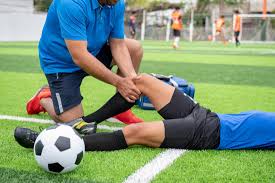ACL Tears in Female Student-Athletes

ACL injuries are more common among female athletes
December 27, 2020
ACL tears are a serious injury that causes a change in your lifestyle. An ACL tear is a tear of the anterior cruciate ligament, which will usually result in surgery if the person injured wants to return to sports.
As an athlete for the past ten years, I have always loved soccer. I’m quite injury prone, and every time I’ve injured myself it wasn’t about the injury–it was about the fact that I was out of soccer. In 5th grade, I ended up getting a Traumatic Brain Injury (TBI), which is a type of severe concussion. I didn’t care that there could be major damage to my brain because it never crossed my mind. All I was scared about was being out of soccer.
Then in 7th grade, I was playing football in gym class and broke my pinky finger when going to catch a ball. The nurse believed that it had just popped out of the socket, so I thought I’d be back to soccer within a few days after the swelling stopped. Once I got to South Shore Hospital, my hopes were quickly diminished after I learned that I completely broke my finger and would possibly need surgery to stabilize the finger.
More recently, I ended up tearing my ACL during the second soccer game of the season. I felt a pop in my knee and went down. I tried to convince myself that it was anything but my ACL, but I knew deep down that it was a big possibility. Three days after injuring myself, I got my MRI results and found out I had completely torn my ACL. I was heartbroken because that meant surgery, physical therapy, and 6-9 months out of soccer, tennis, skiing, and all other activities.
It’s difficult for people to understand the emotional toll that a major injury like this can have on a person. SHS senior Hannah Callanan has torn her ACL twice. Once in September of 2017, during her freshman year, and again in June of 2019 at the end of her sophomore year. Callanan said she feels as though she has never returned to where she was before the injury. She was out for 7 months for her first ACL tear and 13 months for her second ACL tear.
Callanan shared her experience with injury, saying, “Both injuries took a huge toll on my mental health. The first time, it was more confusion and not knowing what to expect. The second time, I struggled a lot more because I knew exactly what was ahead of me and I didn’t know if I could go through it again. Even though I am back to soccer, I can’t play without being cautious and constantly thinking about how I’m running and turning, out of fear.”
Athletic injuries need to be handled with patience and a strong belief in yourself. Callanan is a great example of someone who came back to perform as a great player on the Scituate Girls Varsity team this year.
Chris Alves, the athletic trainer at Scituate High School, is coming in during an unprecedented year. With injuries like an ACL tear, there is not much an athletic trainer can do because it is mainly between the student and their physical therapist and surgeon. Athletic trainers are mainly used in a school system to give a first-hand take on the injury, be able to see how the injury happened, and give some idea of what the injury could be and how severe it is. The athletic trainer is also there to help with the mental toll a major injury takes on a student-athlete, who often already has so much going on with the academic pressures of high school.
According to the Washington Times, “The American Academy of Orthopaedic Surgeons reports that female athletes playing certain sports like soccer and basketball are three to four times more likely to injure their ACLs than their male counterparts. Other experts put the figures much higher.” With female athletes being more prone to ACL tears, implementing strength training in muscles around the knee could help lower these numbers of ACL tears.
Kerry Fogarty, who works at Bay State Physical Therapy in Scituate, is a physical therapist. Having worked with many people who have had ACL tears, Fogarty thinks strength should be built up in certain areas of the leg, especially among female athletes who play lacrosse, soccer, and basketball. According to Fogarty, building strength in the outer hip muscles, the calves, and the hamstring muscles can help prevent injury.
Of course, sports injuries can happen. Implementing prevention programs in female sports like soccer, lacrosse, and basketball, which are most prone to ACL injuries, could help lower the numbers in school communities like Scituate.